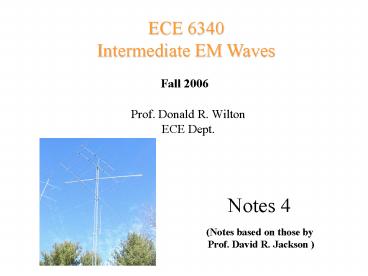ECE 1100 Introduction to Electrical and Computer Engineering PowerPoint PPT Presentation
Title: ECE 1100 Introduction to Electrical and Computer Engineering
1
ECE 6340 Intermediate EM Waves
Fall 2006
Prof. Donald R. Wilton ECE Dept.
Notes 4
(Notes based on those by Prof. David R. Jackson )
2
Debye Model
Explains molecular effects
q
molecule at rest
Molecule
x
-q
molecule with applied field
3
Debye Model (cont.)
s spring constant
c friction constant
4
Debye Model (cont.)
Hence
Assume
5
Debye Model (cont.)
Note that
Hence
Insert this into top equation
6
Debye Model (cont.)
Then we have
or
Assume sinusoidal steady state
7
Debye Model (cont.)
Hence
Denote
The capital P denotes the total dipole moment per
unit volume. The M reminds us that we are
talking about molecules
8
Debye Model (cont.)
Also, for a linear material,
Hence
Therefore
The frequency is fairly low relative to molecular
resonances.
Assume
9
Debye Model (cont.)
Denote the time constant as
Denote the zero-frequency value as
10
Debye Model (cont.)
This would imply that
At high frequency the molecules cannot respond to
the field, so the relative permittivity due to
the molecules tends to unity. This equation
gives the wrong result at high frequency, where
atomic effects become important.
11
Debye Model (cont.)
Include BOTH molecule and atomic effects
Molecule effects
(atoms can respond much faster than molecules)
Atomic effects
12
Debye Model (cont.)
We have that
Hence
13
Debye Model (cont.)
Permittivity formula
where
14
Debye Model (cont.)
Note that
so
Hence
15
Debye Model (cont.)
16
Debye Model (cont.)
Frequency for maximum loss
Let
A maximum occurs at
or
17
Lorenz Model
Explains atomic resonance effects (usually
observed at high frequency)
Atom
qe
qn
qn - qe
Dipole effect
-
18
Lorenz Model
x
Model
Electron equation of motion
19
Lorenz Model
so
For a single atom,
Hence
Sinusoidal Steady State
20
Lorenz Model
The capital P denotes the total dipole moment per
unit volume. The A reminds us that we are
talking about atoms.
Therefore,
21
Lorenz Model
Hence
Denote
22
Lorenz Model
then
Permittivity formula
23
Lorenz Model
A sharp resonance occurs at
24
Total Response
Frequency response for a hypothetical material
(From Ramo, Whinnery, and Van Duzer, Fields and
Waves in Communication Electronics, John Wiley
Sons, 1994.)
PowerShow.com is a leading presentation sharing website. It has millions of presentations already uploaded and available with 1,000s more being uploaded by its users every day. Whatever your area of interest, here you’ll be able to find and view presentations you’ll love and possibly download. And, best of all, it is completely free and easy to use.
You might even have a presentation you’d like to share with others. If so, just upload it to PowerShow.com. We’ll convert it to an HTML5 slideshow that includes all the media types you’ve already added: audio, video, music, pictures, animations and transition effects. Then you can share it with your target audience as well as PowerShow.com’s millions of monthly visitors. And, again, it’s all free.
About the Developers
PowerShow.com is brought to you by CrystalGraphics, the award-winning developer and market-leading publisher of rich-media enhancement products for presentations. Our product offerings include millions of PowerPoint templates, diagrams, animated 3D characters and more.

